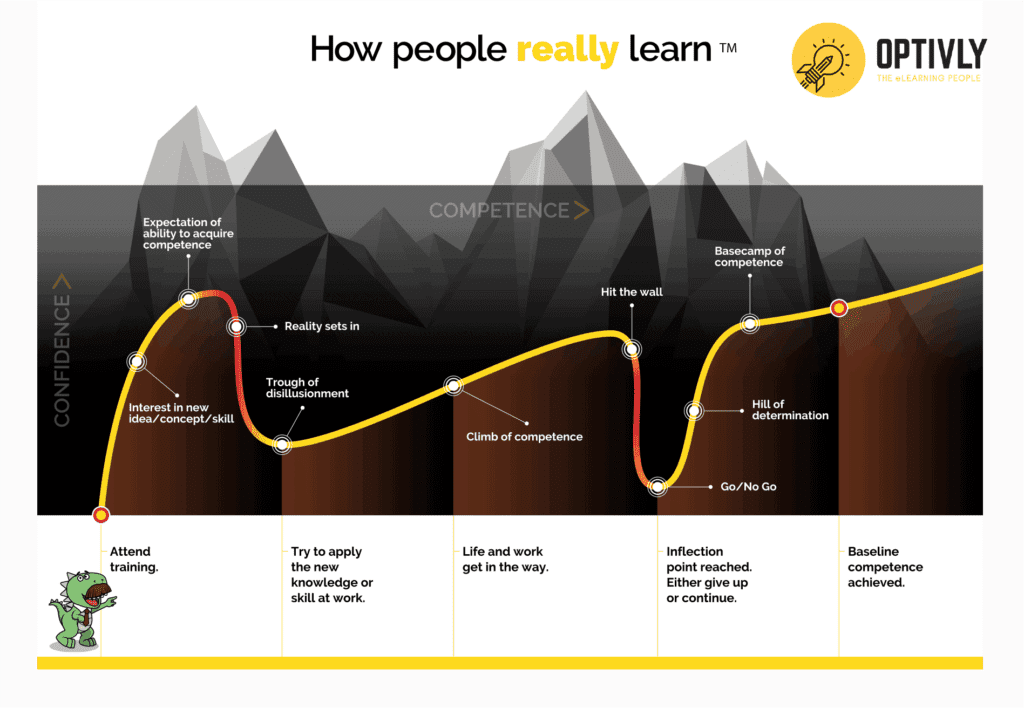
Estimated reading time: 4 minutes
The ugly but important truth about learning a.k.a why a lot of training fails to get the intended results.
- In 2016, close to $400 billion was spent on training and yet 70% of employees report that they don’t have the mastery of the skills needed to do their jobs.
- And here is the killer stat. Only 12% of employees apply new skills learning via L&D programs to their jobs.
A 2000 study by the ASTD reported that only 3% of training reached Kirkpatrick’s level 4 of training evaluation results. That is, where there is an impact on the organisation…
American society for training and development, 2000
Why are we getting training so wrong?
If you look at the learning diagram above you will see the typical learning journey that most people undertake for any new skill. Put simply it starts at expectation versus reality. I see it all the time when my kids attempt something new for the first time whether that’s kicking a soccer ball into a goal, riding a skateboard or playing handball. There is an initial expectation about the difficulty of the task combined with varying amounts of enthusiasm towards the new skill. Reality hits when they find out it’s harder than it looks.
The trough of disillusionment & the go or no go point.
The trough of disillusionment is where we realise that it’s going to take more effort and time than we realised to gain this new skill. This is where we ask some questions of ourselves and either immediately decide – this isn’t for us – or we decide to have another go. If we decide to continue on we pick ourselves up, dust ourselves off and start again. We might give it a few more tries before we hit the wall. This is the go or no go point. This is where we decide whether we really want to get this new skill or live without it.
Where do you think we need support?
It’s pretty obvious isn’t it? We need extra support at the low points. We need some intervention at the trough of disillusionment and at the go/no go point. In reality, we also need it throughout the skill mastery process but it must be there at those crucial points – at the time, on the job, during the time we are trying to apply the new skill.
How does that compare to a lot of training?
If you look at the way a lot of training in the workplace is delivered it is often a single training event. We attend a training session and then off we go back to our jobs to employ that new skill. It is not often that we have someone checking in on us as we first try applying what we learned.
Blended Learning to provide ‘Learning in the Flow of Work’.
Blended learning describes the mix of training delivery where part of the learning is online and part is offline. Training can be delivered in a classroom or onsite. However, as soon as the employee goes back to work they need a mechanism to access help and support when and where they need it. A few examples of this are:
- Discussion Boards – a great way to encourage peer to peer learning. Even better, where a subject matter expert is moderating a discussion and providing some guidance and direction.
- Video based training objects that are short and to the point are also great tools.
- Having everything available via an app making it easy for an employee to check something while on the job.
- Live coaching via a video interface available from a phone or tablet is another great way to provide one on one training while the employee is on the job.
- Mixed Reality tools like Augmented Reality to show someone enhanced information overlayed onto their workplace. Microsoft HoloLens – has some great solutions that allow a trainer/team member to provide heads up display information to the employee on the job without having to be at the same location.
Provide support where people need it the most
If you wanting training to stick and be applied, you need to provide the support at the times when the employee needs it the most. This is now being termed as ‘Learning in the Flow of Work’. It’s not surprising that once off training events don’t work. Training needs to be like teaching your child how to ride a bike. Provide someone to be beside them (virtually is OK). Give them encouragement, provide extra help if needed. Provide them some social proof (Discussion boards and potentially leaderboards) so that they see and hear from other people on a similar path. Give them all the tools they need to support the learning transfer process and then watch them succeed.
